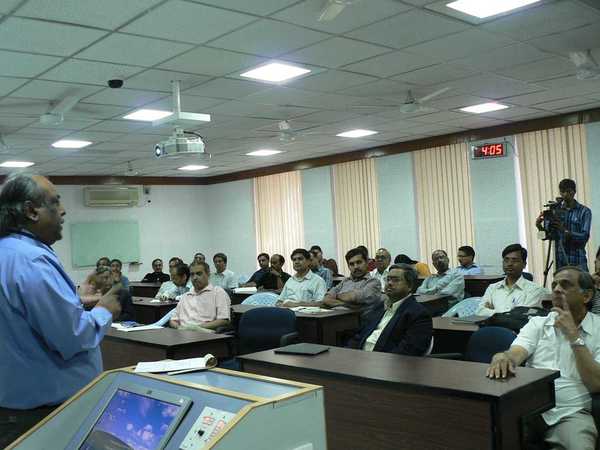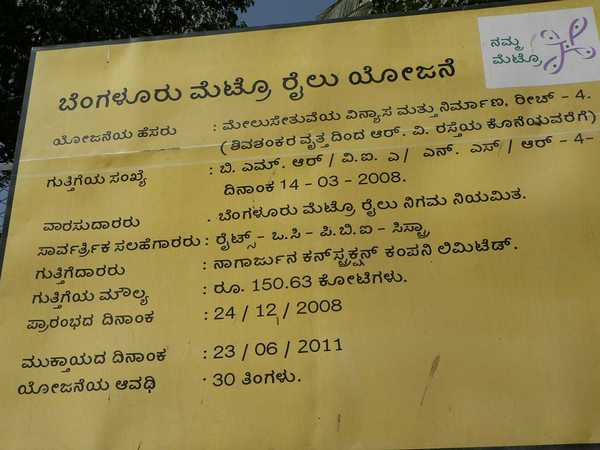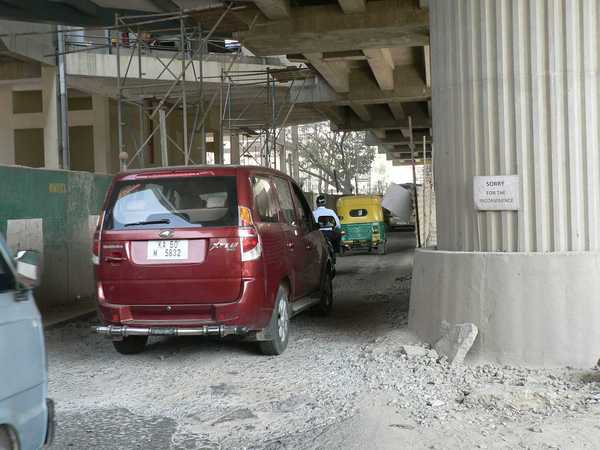"I am sure I have answers to all your questions but I can’t guarantee satisfaction," said a candid N Sivasailam, MD of Bangalore Metro Rail Company Limited (BMRCL), in his opening remarks. He was conversing with Dr Ashwin Mahesh at a discussion on the Namma Metro at IIM, Bangalore, as part of a series on ‘Practice in Public Spaces’, on January 30th.

The first session of the series ‘Practice in Public Spaces’. K Jayraj sets the agenda. N Sivasailam is seated on the front row (in a black jacket). Pic: Shamala Kittane
The discussion series was initiated by K Jayraj, a senior fellow at IIMB and ex-BBMP commissioner. Rajeev Gowda, Professor, IIMB appreciates the initiative, "India is solely lacking in documenting initiatives that involve public spaces and governance." The series aims to address this deficit. The monthly sessions are meant to record experiences of people that are key to managing large projects that affect public spaces to understand how they function and all the management that goes into realising such complex projects.
Jayraj set the agenda of the discussion to cover involvement by stakeholders – the centre and state, what it takes to abate and resolve controversies (land acquisition, the statue of a National leader, trees"), budget allocation and co-ordination, design issues (like the frequently asked – did Metro mess up MG road?) and displacement and rehabilitation.
Sivasailam focused on the internal management of BMRCL and financial aspects in his presentation and later responded to audience questions.
Sivasailam informed that BMRCL has won all 350 public interest litigations filed against them. They have also managed to provide housing facilities for slum dwellers displaced due to Metro, this has apparently helped reduce alcoholism rates and even domestic abuse cases.
Sivasailam brought up the issue of bad roads as a result of Metro work, when questioned about Metro’s interaction with the government.

Board shows project details of Metro construction between Shivashankar Circle and R V road. It mentions an end date of June 2011. RITES Consultant engineer Kiran Kumar said the project may complete by 2014 and. It is also dependent on the underground Metro construction happening near M N Krishna Rao Park. Pic: Shamala Kittane.
Any infrastructure project involves close interaction with BBMP and the sheer magnitude of the city’s largest infrastructure project makes the dealing with the corporation a daily business.
"If people are complaining about bad roads as a result of Metro work, then we expect the municipal authority’s support – it is a struggle between the two of us since it’s also fair for them to say — we dug up the roads so we need to repair it." said Sivasailam. Accountability will be included at the policy level in the Metro phase-2 project plans to avoid such issues, he added. The question of who will fix the current set of bad roads where Metro work is currently happening remained unanswered.
It is not Metro’s job to provide for parking spaces argued Sivasailam, "it is an ‘institutional confusion’", which will be eliminated in framing a clear policy for Metro phase-II.

‘Sorry for the inconvenience’ and no path for pedestrian movement. Pic: Shamala Kittane
The operation costs of the Metro will be covered if 30% of ‘Peak Hour Peak Distance Traffic (PHPDT)’ opts for Metro commute. Tickets are priced at Rs. 10 per station and a discount of 15% are offered for the ‘Metro card holders’ plus an additional 10% discount for point-to-point travel.
The Metro MD explained the reason for adopting rail-traction over overhead traction — rail traction is more aesthetic and avoids the clutter of overhead wires and associated tree felling.
Sivasailam responded to questions on the MG Road boulevard, "it was used as a place for ablutions. Even if it did look beautiful, it was dirty. Metro will turn this into a better space that a future generation might want to protect". At MG Road, the metro could not go underground, as it is technically not feasible. An underground rail needs a 800 metre ramp to enter and exit, and this is not available for exit after MG Road and the whole eastern line would have to go underground for this to be possible – this means a huge resource and financial allocation.
Projects like the Metro that spans over many years impacts the city in complex ways – it becomes the imposing background of somebody’s childhood, the loss of a tree lined road could be the loss of a cherished pace, a new tin-home to a young labourer couple from another part of the country. Kudos to IIMB in taking that small step towards the much needed effort of documenting public spaces.⊕